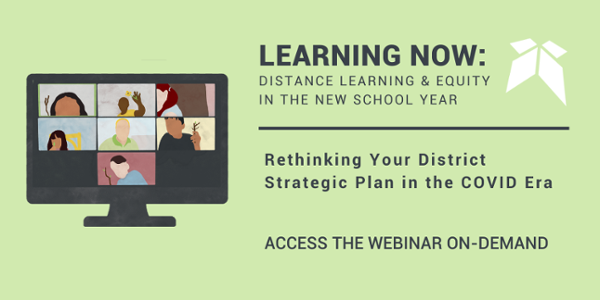
by: dana britt and andrea goetchius on february 23rd, 2021
rethinking your district strategic plan in the era of covid-19
strategic planning | district leadership | school leadership
what’s the first word that pops into your head when you hear “strategic planning”? what word did you think of? common responses we hear are boring, painful, old-school, far-off, or even just a simple, “ugh.”
we’ve worked for the past 10 years with districts across the country to revamp planning of all types, from strategic plans to personalized learning implementation plans to getting started with equity. last fall, all of us were faced with a new type of planning – “return to school.” what lessons have we learned from planning this past fall that we see districts applying to their strategic plans moving forward?
successful district strategic plans in the covid era will be:
1. shorter-term
someone, somewhere long ago decided that strategic plans “must” be five years long. given turnover in some district leadership after only two or three years, we’ve been seeing districts reconsider the scope that their strategic plans cover, even before covid hit.
now, given that it’s unclear when a vaccine will be widely used and effective, many experts are predicting that masks and social distancing will be the normal way of life until 2022 or beyond. as many districts found last summer, planning while state and local guidance is uncertain can lead to frustration, duplication, and anxiety.
despite the challenges, our district partners found success in creating their return to school plans last fall. how can districts apply what they’ve learned from shorter-term return planning to their overarching strategic plans? we predict that moving forward, strategic plans will focus primarily on the next 1-3 years versus 3-5, releasing the pressure of being clairvoyant while in a time of constant disruption.
2. flexible
strategic plans moving forward must be extremely flexible in order to bend and not break through these changing times. we don’t want to hear district leaders saying, “well that whole part of the plan needs to be thrown out the window now because of covid.” a successful strategic plan in the covid era will focus on the outcomes more than the inputs, like these plans from two of our partner districts (example 1, example 2). that does not mean, however, that all elements must be flexible because there are some components that should remain fixed as your district’s north star to guide you through uncertainty. it will be important to align with stakeholders during your strategic planning process on the fixed versus flexible elements so that they know what will remain unchanged versus what may be constantly updating.
|
examples fixed: mission, vision, values or beliefs, outcomes flexible: priorities to meet the vision + outcomes, and initiatives under those priorities |
creative ways of monitoring the success of the fixed and flexible elements will also be needed. determining when to keep moving forward in the same direction and when to “change tack” will be crucial. this is called a pivot, which according to eric ries, author of the lean startup, is a change in strategy without a change in direction.
read the blog post
working on working: how to make deliberate decisions that respond to the needs of your team
3. community-driven
the shift to virtual instruction has led to unexpected and amazing opportunities for virtual community engagement. leaders are reporting unprecedented numbers of community members attending board meetings, joining virtual forums, and engaging on social media. based on a front-row seat to remote and hybrid learning in their homes, families have had a unique perspective of what it takes to provide great instruction. it’s essential to keep communities engaged and provide them with many choices to participate – to understand student expectations, the support provided by the organization, as well as to provide feedback. here are a few questions to consider asking your stakeholders that could reveal insights into your next strategic plan.
|
4. reflective
the fall felt like a “pause” in many senses. we paused on weddings and other celebrations. we paused on routine activities and doing things “the way we’ve always done them.” many leaders are accepting the opportunity the pause has afforded them to become increasingly reflective about the “way we do school.” many are using the pause to reflect on their own leadership or to engage their teams in retrospectives about the way they work together.
strategic plans in the covid era will have defined checkpoints for reflection because of their emphasis on being shorter-term and flexible. some districts are considering these checkpoints as part of “sprints.” built-in points for reflection will be crucial as we navigate the unknown for the remainder of this school year and the next.
5. re-focused
the focus of strategic plans moving forward may be very different. as a country, we are reckoning with systemic racism, reimagining school for virtual or hybrid models, and navigating a politically divisive culture. our focus should change the more we learn and evolve. we anticipate districts will be prioritizing:
-
hiring and retaining a strong workforce of teachers and school leaders given the risk of many leaving the profession
-
an emphasis on hiring and retaining teachers of color, in particular, black teachers
-
flexible work environments where teachers can maintain flexible schedules and pursue passion projects
-
increased support for parents and caretakers in navigating the school’s systems and supporting their children at home
what are your predictions about how district strategic plans will be different moving forward? how have you seen your district’s plan evolve already?


